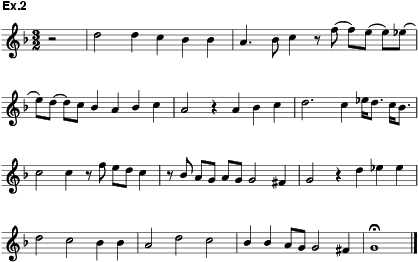
In Western notation a vertical line drawn through the staff to mark off metrical units. Hence also the metrical unit thus indicated, which in American usage is called ‘measure’. English usage often relies on context alone to make the distinction clear (e.g. ‘up to the double bar’, ‘the end of the bar’), but ‘bar-line’ is also common.
Vertical lines were occasionally used in early polyphonic music, written in score to help align the voices and text (e.g. GB-Lbl 36881; Cu Ff.1.17; the Codex Calixtinus, E-SC; facs. of E-SC f.187v in Besseler and Gülke). But most of the ‘classical’ repertories of the 13th (Notre Dame or Parisian, Ars Antiqua), 14th (Ars Nova, Ars Subtilior etc.), 15th and 16th centuries, though written in regular metres, did not use bars. Only the earliest of these repertories, however, regularly used score notation.
The earliest repertories to employ bar-lines at regular metric intervals – keyboard and lute (vihuela) music – were written in Tablature. Tablature never used ternary divisions of note values, and was in other respects less ambiguous than staff notation; possibly the fact that it usually represented polyphonic textures made further clarification desirable. Bar-lines are found in, for example, the Faenza Codex (I-FZc 117, written 1400–20, facs. in MD, xiii–xv, 1959–61), Conrad Paumann’s Fundamentum organisandi (1452) and the Buxheim Organbook (D-Mbs mus.3752, written 1450–70, facs. in DM, 2nd ser., i, 1955). In England bars of irregular length are found in keyboard sources as late as the Fitzwilliam Virginal Book (GB-Cfm 32.g.29, written 1609–19).
Polyphonic vocal music of the Renaissance was not notated in bars, except when set out in keyboard Partitura (‘score’) at the end of the 16th century. Cipriano de Rore’s Madrigali … a quattro voci spartiti et accommodati per sonar d’ogni sorte d’istromento perfetto et per qualunque studioso di contrapunti is the first such score (facs. in Festschrift Karl Gustav Fellerer, 1962, p.144). Solo parts and partbooks did not use bars until the beginning of the 17th century. (Besseler and Gülke, p.147, shows an opening from John Dowland’s First Booke of Songes or Ayres of Foure Partes, 1597: the lute and cantus parts on the one page are barred, but not the other three parts on the opposite page.)
Bar-lines did not always immediately precede the main accented beat; in other words, first beat of the bar and strong beat did not always coincide, particularly in the late 16th and early 17th centuries. This might result in bars of shorter length than would be usual today, in other words with a bar-line after each beat rather than after each bar of modern transcription. There was often a preference for bars in duple or quadruple rather than ternary metre. Ex.1 shows a passage in Altri canti di Marte from Monteverdi’s eighth book of madrigals: (a) gives the original barring, (b) a barring according to accent. Another well-known instance is the beginning of the Partite sopra l’aria della Romanesca from Girolamo Frescobaldi’s Toccate … partite … corrente … libro primo (1637; see illustration). Frescobaldi’s barring does not recognize an upbeat, and simply divides the beats into arithmetical groups. Ex.2 gives a barring according to accent. (For many other such examples, from early operas, see H. Riemann: Handbuch der Musikgeschichte, ii/2, ed. A. Einstein, 1912, 3/1921, p.195.)


The illustration also shows accidentals repeated later in the bar if other notes intervene, a practice that persisted up to the mid-18th century (it is found in most Bach and Handel autographs). Subsequent practice allowed that an accidental be effective throughout the bar where it appeared, but not after it.
After the mid-17th century it became the rule to precede main beats with bar-lines; Stravinsky’s The Rite of Spring (1913) is a classic example of a score barred irregularly for this reason.
J. Wolf: Handbuch der Notationskunde (Leipzig, 1913–19)
W. Apel: The Notation of Polyphonic Music 900–1600 (Cambridge, MA, 1942, 5/1953)
C. Dahlhaus: ‘Zur Entstehung des modernen Taktsystems im 17. Jahrhundert’, AMw, xviii (1961), 223–40
H. Besseler and P. Gülke: Schriftbild der mehrstimmigen Musik, Musikgeschichte in Bildern, iii/5 (Leipzig, 1972)
DAVID HILEY